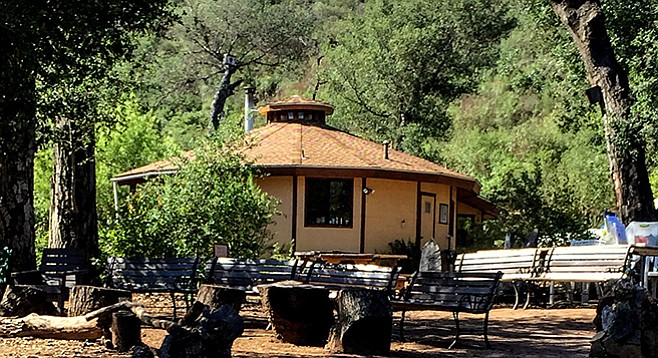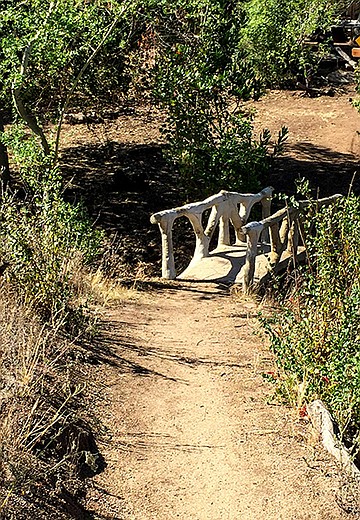 Facebook
Facebook
 X
X
 Instagram
Instagram
 TikTok
TikTok
 Youtube
Youtube

There is something for every nature lover and even those who only want to get a bit of exercise at Silverwood Wildlife Sanctuary. With a network of nearly 5 miles of trails, there are both easy walking paths through shady oak woodlands and more extensive paths through the chaparral where there are many wildflowers that bloom in late winter and spring. Hiking up to the ridgeline provides outstanding views of the surrounding mountains and out to the ocean. It is also a great place to learn about birds at the sanctuary’s observation area and nature center, which is to be expected since it is owned and operated by the San Diego Audubon Society. Tours are also available.

From the parking area, start hiking southeast on the Harry Woodward Trail, named for the man who gave 85 of these acres as a gift to the Audubon Society to start Silverwood. This is an easy self-guided trip through chaparral with many shrubs identified with signs. Among those found here are holly-leaf cherry, mission manzanita, spice bush, buckwheat, and scrub oak, as well as other species making up the chaparral covering most of San Diego’s foothills. Currently this area is dominated by whitethorn ceanothus, a tall, but short-lived California lilac that forms dense thickets after a fire, a reminder that Silverwood was completely destroyed in the 2003 Cedar Fire. Fortunately, it has made a dramatic recovery.
Turn right at the Chaparral Trail to continue the self-guided tour where more chaparral shrubs are identified with signs, including chamise, chaparral yucca, sugar bush, and laurel sumac. Up ahead, across a bridge over an intermittent creek, is the bird observation area, a place to get acquainted with some of the more than 100 species of birds that visit or live in the sanctuary. Those likely to be seen include scrub jays, spotted towhees, hooded orioles, and California quail.
After exploring the bird observation area, return to the Chaparral Trail and continue east until the Spring Trail. Go right on the trail where it will soon be crossing an open grassy area with very few chaparral shrubs. In a normal rainfall year, this will be a marshy area, or cienaga, home to blue-eyed grass, Indian paintbrush, grasses, and rushes.

Continuing on beyond the cienaga, the Spring Trail intersects with the Circuit Trail. Go left on the Circuit Trail, which continues up to the backbone of the ridge and crosses the “Big Rock Slab,” a large granite outcropping nearly devoid of plants, except for mosses, silver-leaf lotus, and a few dudleyas growing in the cracks. The Circuit Trail loops around the sanctuary, eventually returning to the entrance. As it does so, it will intersect with six other trails that could be explored if time permits. One highly recommended for outstanding views is the Howie Wier-Rady’s View Trail up to the sanctuary’s high point at 2100 feet. There is also a self-guiding Geology Trail that is compelling and informative.
Distance from downtown San Diego: 28 miles. Allow 35 minutes driving time (Lakeside). Take I-8 E to El Cajon and exit onto SR-67 and go north to Lakeside. Turn right (east) on Mapleview St. At the stop sign, turn left (north) on Ashwood St., which will become Wildcat Canyon Rd. Continue for 4.8 miles toward the Barona Casino to the Silverwood Wildlife Sanctuary on the right.
Hiking length: 2-mile loop.
Difficulty: Moderate. Elevation gain/loss up to 1000 feet. Facilities and water available.
Hours open: 9 a.m.–4 p.m. Sundays only.


There is something for every nature lover and even those who only want to get a bit of exercise at Silverwood Wildlife Sanctuary. With a network of nearly 5 miles of trails, there are both easy walking paths through shady oak woodlands and more extensive paths through the chaparral where there are many wildflowers that bloom in late winter and spring. Hiking up to the ridgeline provides outstanding views of the surrounding mountains and out to the ocean. It is also a great place to learn about birds at the sanctuary’s observation area and nature center, which is to be expected since it is owned and operated by the San Diego Audubon Society. Tours are also available.

From the parking area, start hiking southeast on the Harry Woodward Trail, named for the man who gave 85 of these acres as a gift to the Audubon Society to start Silverwood. This is an easy self-guided trip through chaparral with many shrubs identified with signs. Among those found here are holly-leaf cherry, mission manzanita, spice bush, buckwheat, and scrub oak, as well as other species making up the chaparral covering most of San Diego’s foothills. Currently this area is dominated by whitethorn ceanothus, a tall, but short-lived California lilac that forms dense thickets after a fire, a reminder that Silverwood was completely destroyed in the 2003 Cedar Fire. Fortunately, it has made a dramatic recovery.
Turn right at the Chaparral Trail to continue the self-guided tour where more chaparral shrubs are identified with signs, including chamise, chaparral yucca, sugar bush, and laurel sumac. Up ahead, across a bridge over an intermittent creek, is the bird observation area, a place to get acquainted with some of the more than 100 species of birds that visit or live in the sanctuary. Those likely to be seen include scrub jays, spotted towhees, hooded orioles, and California quail.
After exploring the bird observation area, return to the Chaparral Trail and continue east until the Spring Trail. Go right on the trail where it will soon be crossing an open grassy area with very few chaparral shrubs. In a normal rainfall year, this will be a marshy area, or cienaga, home to blue-eyed grass, Indian paintbrush, grasses, and rushes.

Continuing on beyond the cienaga, the Spring Trail intersects with the Circuit Trail. Go left on the Circuit Trail, which continues up to the backbone of the ridge and crosses the “Big Rock Slab,” a large granite outcropping nearly devoid of plants, except for mosses, silver-leaf lotus, and a few dudleyas growing in the cracks. The Circuit Trail loops around the sanctuary, eventually returning to the entrance. As it does so, it will intersect with six other trails that could be explored if time permits. One highly recommended for outstanding views is the Howie Wier-Rady’s View Trail up to the sanctuary’s high point at 2100 feet. There is also a self-guiding Geology Trail that is compelling and informative.
Distance from downtown San Diego: 28 miles. Allow 35 minutes driving time (Lakeside). Take I-8 E to El Cajon and exit onto SR-67 and go north to Lakeside. Turn right (east) on Mapleview St. At the stop sign, turn left (north) on Ashwood St., which will become Wildcat Canyon Rd. Continue for 4.8 miles toward the Barona Casino to the Silverwood Wildlife Sanctuary on the right.
Hiking length: 2-mile loop.
Difficulty: Moderate. Elevation gain/loss up to 1000 feet. Facilities and water available.
Hours open: 9 a.m.–4 p.m. Sundays only.
Comments